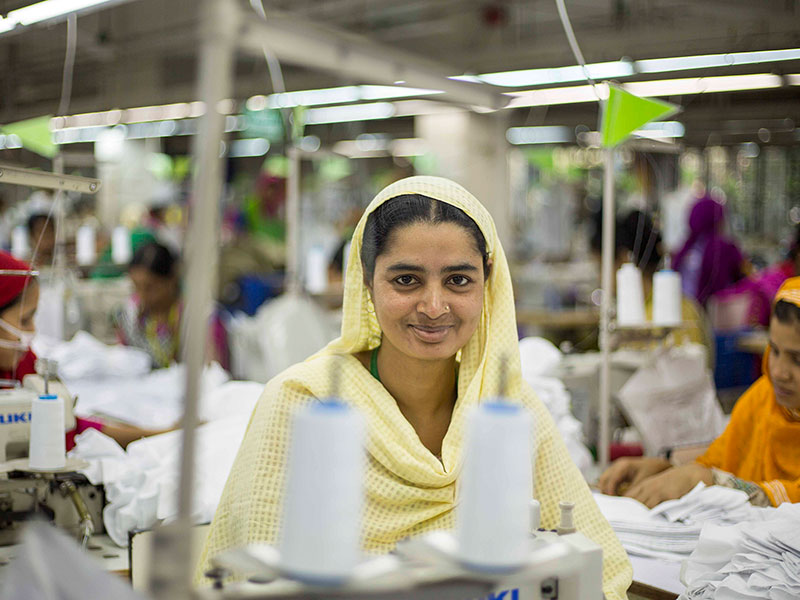Top Procurement Priorities to 2025
Based on BSR’s engagement with procurement leaders within our network, targeted dialogues held with senior leaders in 2017, and a review of external insights on Chief Procurement Officer (CPO) priorities and procurement trends,01 we have identified five key procurement priorities that shape the procurement function’s mandate today and will continue to influence supply chain management through 2025.
Key Forces of Change to 2025
Leveraging BSR’s research, consulting engagements, and collaborative initiatives focused on the key topics shaping business and sustainability, we identify five key forces of change likely to have significant impacts on supply chains from today to 2025. While we and other experts are confident that these trends will be relevant in 2025, significant uncertainty remains about the ways in which they will develop, precisely how they will impact supply chains in different industries and geographies, and how they will interact with and influence one another.
1. Widespread Adoption of Technology, Including Automation, Across the Value Chain
Technological advances are catalyzing the digitalization of supply chain management, changing how products and services are made and delivered, and enabling the creation and sharing of supply chain information in new ways by a more diverse set of actors. Companies are digitally transforming the management of their supply chains by piloting and applying technologies such as machine learning, blockchain, and augmented reality to traditional supply chain management activities.03 Supply chains are becoming hyper-transparent as suppliers, workers, and communities access increasingly sophisticated technologies and use them to create and share information about environmental and social performance. Automation and advanced manufacturing are already having significant impacts on supply chains and will continue to reshape the labor force and the total costs of sourcing, especially in industries that are suited for automation (e.g. electronics), and in countries that have traditionally been the engines of global supply chains.04 These shifts are likely to have several implications for procurement leaders: altering the supplier base as some suppliers adopt new technologies while others are left behind, changing the landscape of common labor-related issues in supply chains, creating new challenges related to workforce displacement, and facilitating access to a huge volume of real-time supply chain information that is produced and validated by many supply chain actors.
2. Global Climate Change and Resource Scarcity
While the exact effects of climate change in supply chains cannot be precisely predicted, supply chains are particularly vulnerable to the impacts of climate change due to their reliance on raw materials and concentration in countries likely to be impacted by climate change. In BSR’s report on this topic in 2015, we found that companies were already identifying climate impacts to their supply chains—including changes in quality and availability of raw materials, commodity price volatility, severe supply disruptions due to natural disasters, and worker health impacts due to rising temperatures.05 These impacts are likely to increase in frequency and severity as global temperatures continue to rise. For example, according to the WHO, ILO, and UNDP, by 2030, productivity losses related to heat-related workplace disruption and injury could rise above US$2 trillion.06 Based on BSR’s analysis of supplier information reported to CDP, most suppliers do not have the tools to evaluate or manage the potential impacts of climate change and resource scarcity to their businesses.07
3. Human Migration on a Mass Scale
Transnational labor migration is an established trend, but the past several decades have seen an increase in mass migration, with more than 240 million people living outside their countries of birth.08 More recently, we breached an ominous global milestone: the greatest number of forcibly displaced people ever recorded. By the end of 2016, a staggering 65 million individuals had been forcibly displaced—a rate equivalent to 20 people forced to flee their homes due to persecution, violence, or conflict every minute.09 Internal migration within countries like China also contributes to changing labor dynamics and is projected to increase.10 This mass movement of people and the circumstances of their migrations have shifted economic potential within countries and introduced new challenges and opportunities for companies seeking to respect and support human rights across their global supply chains. For example, migrants are particularly vulnerable to labor abuses due to language barriers, lack of formal networks, and limited legal protections.
4. Shifting Consumer Demands and Changing Market Demographics
Advances in digital technology have enabled high levels of personalization in marketing and product design and fuel the growing on-demand economy.11 In the U.S. alone, consumers are spending nearly US$60 billion in on-demand services such as online marketplaces and transportation.12 Adding complexity to this trend, as companies look to meet demand for custom goods and faster delivery times in some parts of the world, they are also looking for growth opportunities in new markets and among new customer groups, including “base-of-the-pyramid” populations. These dynamics are likely to push companies in a range of industries to site sourcing and finished goods manufacturing to be closer to end customers. By 2025, many supply chains may shift from global flows of goods and services to national, regional, and local networks of buyers and suppliers.
5. Mixed Signals on Trade and Transparency
In the years ahead, the business models that gave rise to global supply chains may be unwound by direct challenges to, or even simply uncertainty about, the durability of global trade agreements and norms. BSR member companies already report fundamental supply chain changes—such as reshoring, vertical integration, and increased sourcing from new geographies—as a consequence of the mixed signals in our global trade system and planned shifts in economic models, such as China’s pivot from a manufacturing powerhouse to a service economy with expansionist ambitions. Regulations that impact supply chain transparency and disclosure are similarly uncertain; legislation may be rolled back in some jurisdictions but strengthened in others. For example, as the U.S. looks to weaken the Dodd-Frank Act, which requires corporate disclosure on tax payments and on conflict minerals due diligence, France adopted the “duty of care” law, requiring French companies to implement due diligence plans to address human rights and environmental risks. As the U.S. regrettably announced its intent to withdraw from the Paris Agreement, hundreds of university presidents, mayors, and governors in U.S. cities and states redoubled their commitments to the international accord.13
The Supply Chain of the Future
To design a supply chain that is fit to flourish in 2025, supply chain leaders should anticipate how key forces of change will impact their supply chains and look to evolve their supply chain management approaches accordingly. This inflection point is an opportunity for forward-thinking supply chain leaders to build future-fit supply chains that both drive progress on top procurement priorities and advance the sustainable business agenda.
Though there is significant uncertainty in how these forces of change will unfold, supply chain leaders can take concrete steps today to plan for a broad set of possible future scenarios.
Below are five recommendations for how companies can embrace and capitalize on the key forces of change that are changing supply chains and achieve their top procurement priorities in the process. BSR will be working with companies over the next year to test these recommendations and identify other solutions to add to this initial list.
1. Plan for the Supply Chain Impacts of Automation and Migration
Mass migration on a scale previously unimaginable, combined with projections that significant numbers of workers will be displaced by automation, will increase volatility in supply chain labor dynamics; companies need to evolve their approaches accordingly. Companies can mitigate this volatility through fostering responsible and inclusive labor practices. For example, businesses sourcing from regions impacted by mass migration can re-direct resources to engage with industry peers and cross-border actors, including government, labor unions, and employers, to reinforce legal frameworks and insist on better enforcement of labor laws. Companies with supply chains that expect significant uptake of automation through 2025 can insist that key suppliers develop clear plans to support a sustainable workforce transition.14 Business can also support the empowerment of individual workers within their supply chains through enabling them to participate in and lead trade unions and other forms of worker representation, by using technology like mobile apps to help workers understand their legal rights, and through evolving technologies that directly gather workers’ views.15
Supports the Following Top Procurement Priorities
- Improving risk prediction and management
- Providing strategic foresight to the business
- Innovating and collaborating with suppliers
2. Build Responsible Regional Sourcing Hubs
Growth in new markets and demographics and meeting customer demands for customized, on-demand goods and services will require understanding and meeting new consumption patterns and preferences, as well as providing goods and services in new locations and formats. In response, supply chain leaders will have an opportunity to develop nimble, regional supplier networks that can meet both commercial expectations and sustainability aspirations. Companies can build on the lessons learned in well-worn sourcing locations such as China to develop smart sourcing models in emerging hubs such as sub-Saharan Africa.16 Supply chain leaders will have the chance to embed social and environmental responsibility into the design of these regional sourcing hubs and to leapfrog supplier monitoring activities that have not delivered improvements in labor conditions or environmental resilience.
Supports the Following Top Procurement Priorities
- Providing strategic foresight to the business
- Innovating and collaborating with suppliers
- Saving costs and optimizing working capital
3. Digitalize Supplier Assessment and Engagement
With more data about supply chains produced and disseminated than ever before, supply chain leaders have the opportunity to rethink how they collect and interpret supply chain information. Practitioners will need to hone in on the supply chain information that is decision-useful in a sea of available data and dashboards and will need to reconsider which data they need to commission and how it is collected. Supply chain leaders looking to the future should firmly weigh the value of investing resources in a battery of one-time, on-site supplier audits when open access channels, such as the IPE Blue Map, already publicize factory emissions and wastewater in real time, and numerous digital platforms exist today to assess worker satisfaction and engagement, as described by workers themselves.17 In supply chains likely to be disrupted by automation, recalcitrant labor issues like wages, working hours, and safety are likely to be supplanted by new challenges such as responsible down-sizing and re-skilling of supply chain workers. Today’s audit and remediation processes will hardly be fit for purpose to support responsible factory closures or retraining programs, and therefore supply chain leaders planning for the impact of automation will need to guide their teams from a focus on corrective action plans toward leading a sustainable transition in partnership with their suppliers.18
Supports the Following Top Procurement Priorities
- Saving costs and optimizing working capital
- Improving risk prediction and management
- Providing strategic foresight to the business
- Innovating and collaborating with suppliers
4. Strengthen Supply Chain Transparency and Disclosure
In the context of high levels of uncertainty about the future of global trade and of the regulations that shape mandatory corporate disclosures about sourcing practices, futuristic supply chain leaders can prepare for a variety of possible future scenarios through enhancing both visibility into supply chain practices and disclosures about those practices. Enhanced transparency will support supply chain leaders in the case that global trade is transformed by political shifts toward economic nationalism and will be valuable should free trade continue. Likewise, improving the quality and scope of supply chain disclosure will enable practitioners to stand ready should regulatory requirements increase and to weather the increased stakeholder scrutiny that is the likely corollary of a weaker regulatory environment.19
Supports the Following Top Procurement Priorities
- Providing strategic foresight to the business
- Innovating and collaborating with suppliers
5. Embed Climate-Smart Supply Chain Planning
To prepare for the changing physical environment and other supply chain risks related to global climate change, companies will need to factor climate risk and preparedness into supply chain planning models, seek alternative materials and resources where necessary, and look for new ways to secure supply and minimize disruptions in their supply chains.20 This will also mean partnering with suppliers that share a commitment to climate awareness and action and providing incentives and access to technical and management skill-building to suppliers that lag behind peers. Suppliers situated in jurisdictions that have already made policy commitments to transition to low-carbon economies—such as China and India—are likely to accelerate their contributions to global buyers’ visions of climate-smart supply chains. In all industries, climate-smart supply chain planning should become a fundamental part of good supply chain management from today to 2025.
Supports the Following Top Procurement Priorities
- Improving risk prediction and management
- Providing strategic foresight to the business
- Saving costs and optimizing working capital
Let’s talk about how BSR can help you to transform your business and achieve your sustainability goals.


